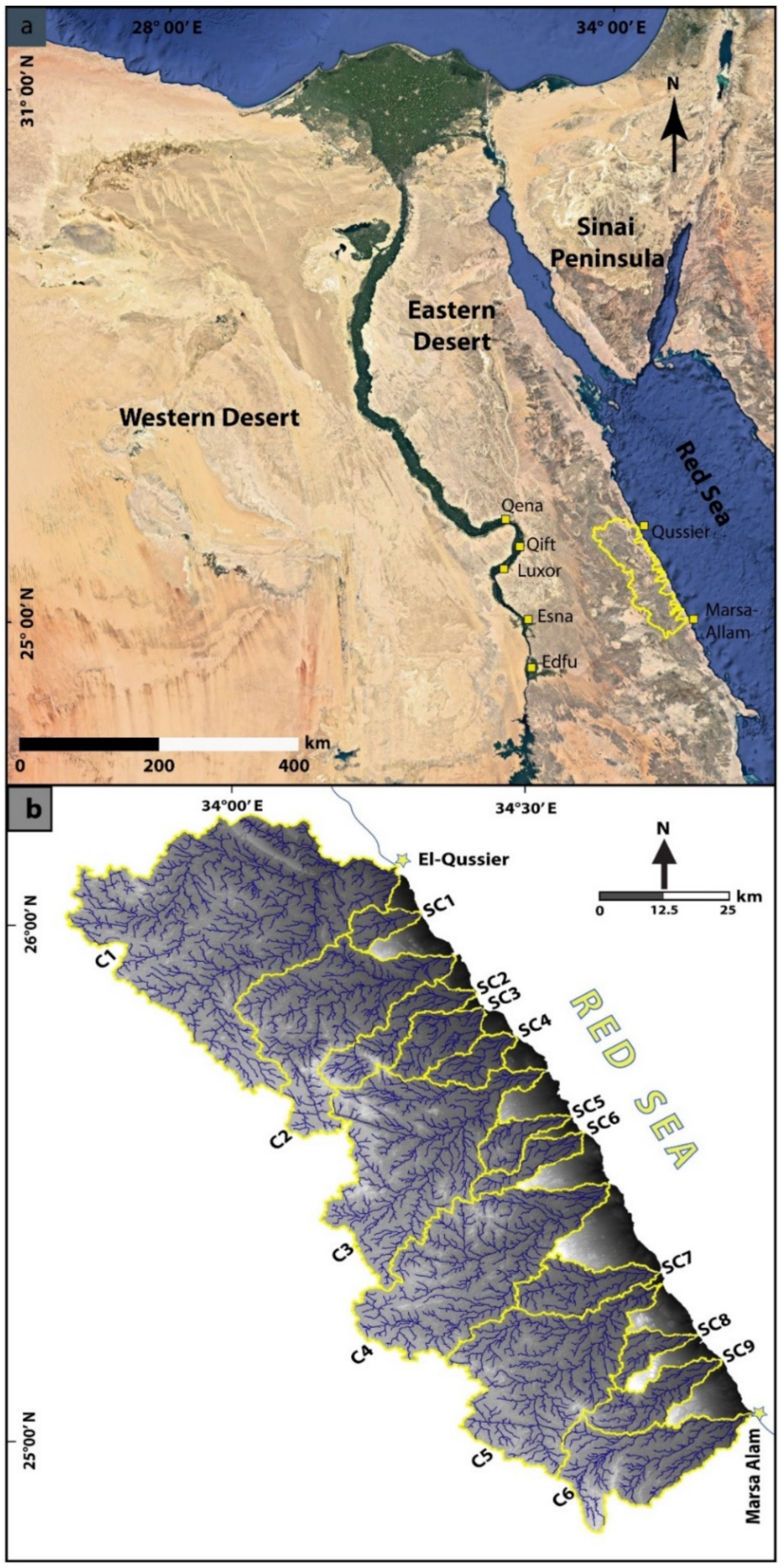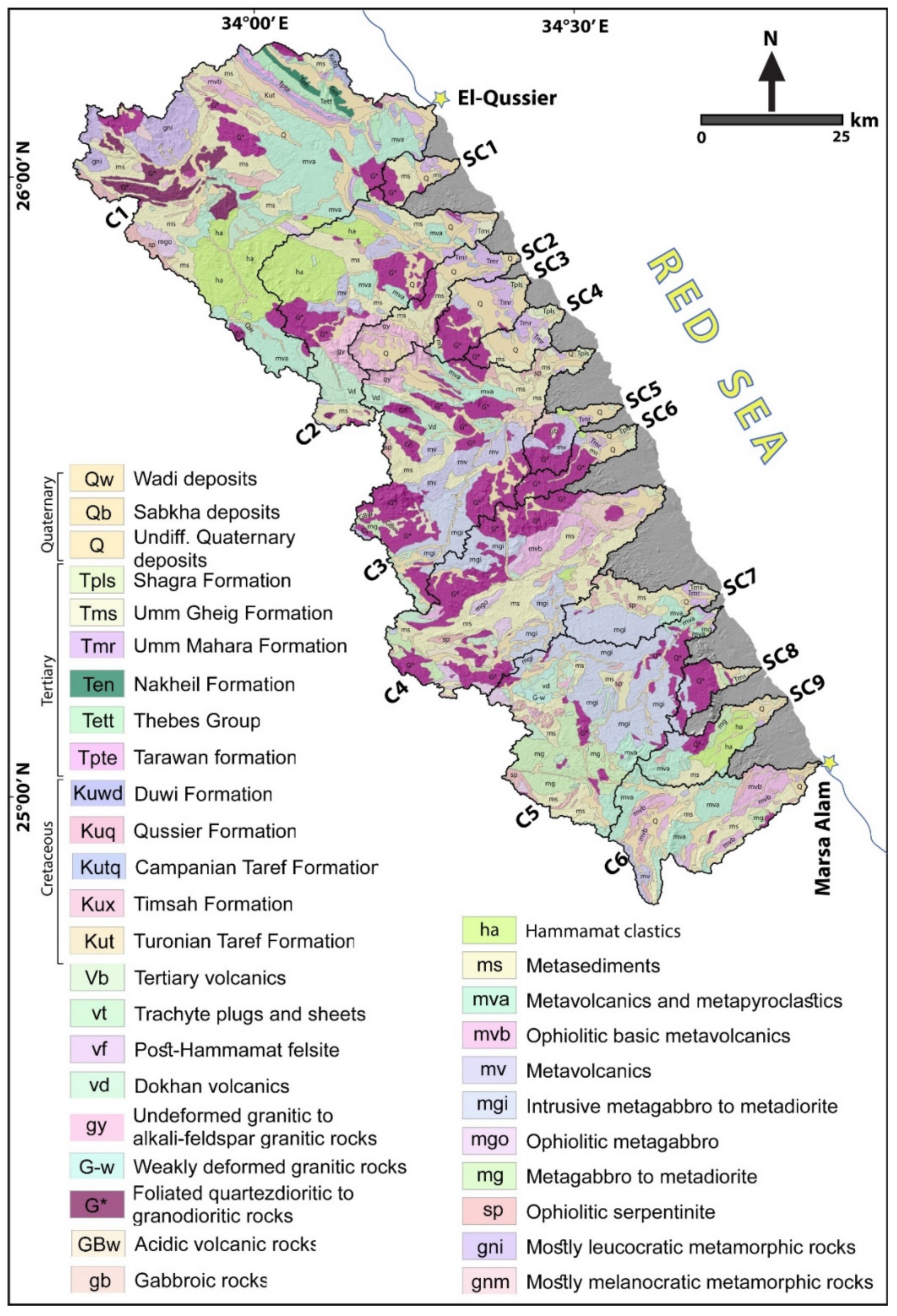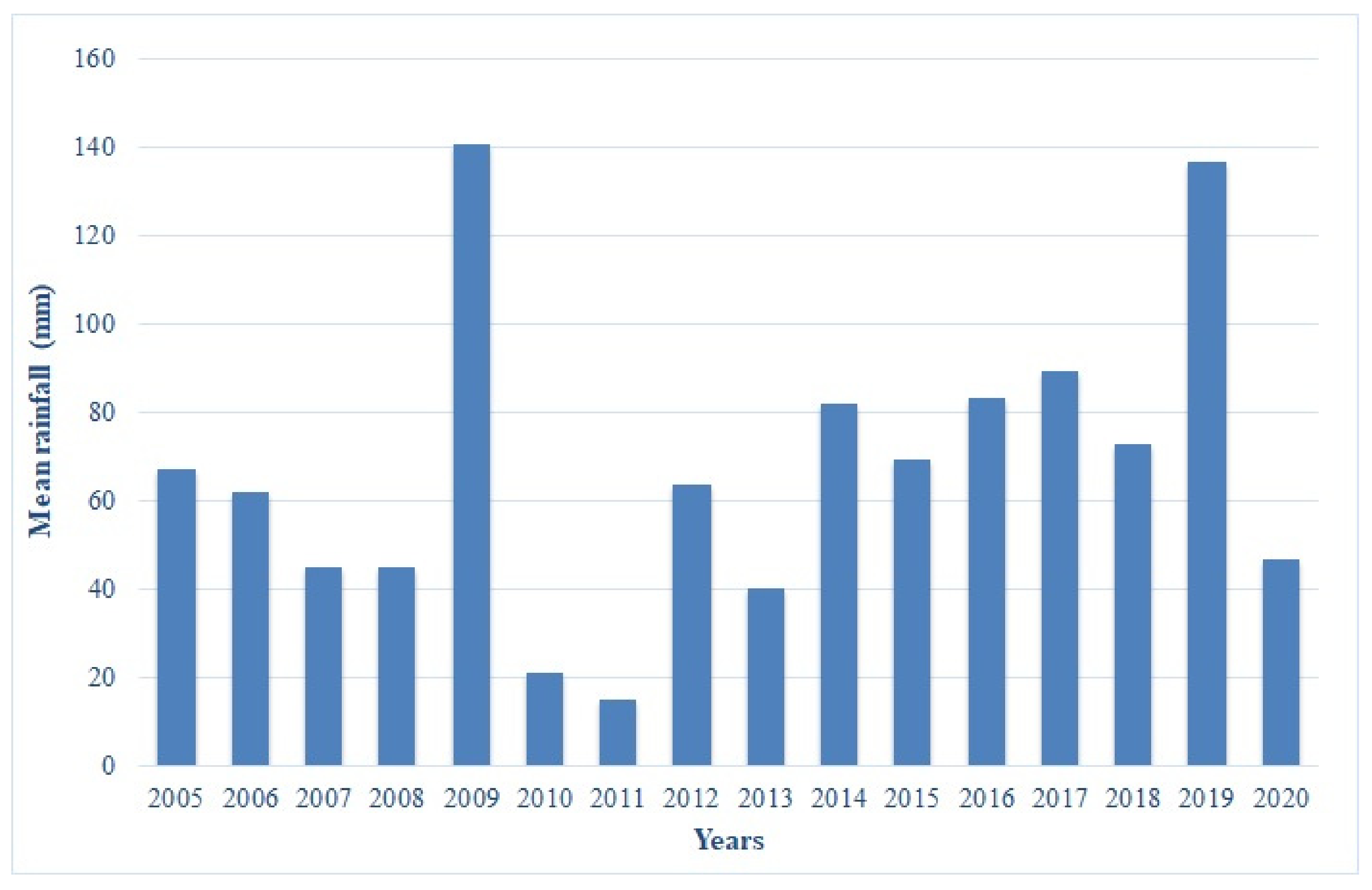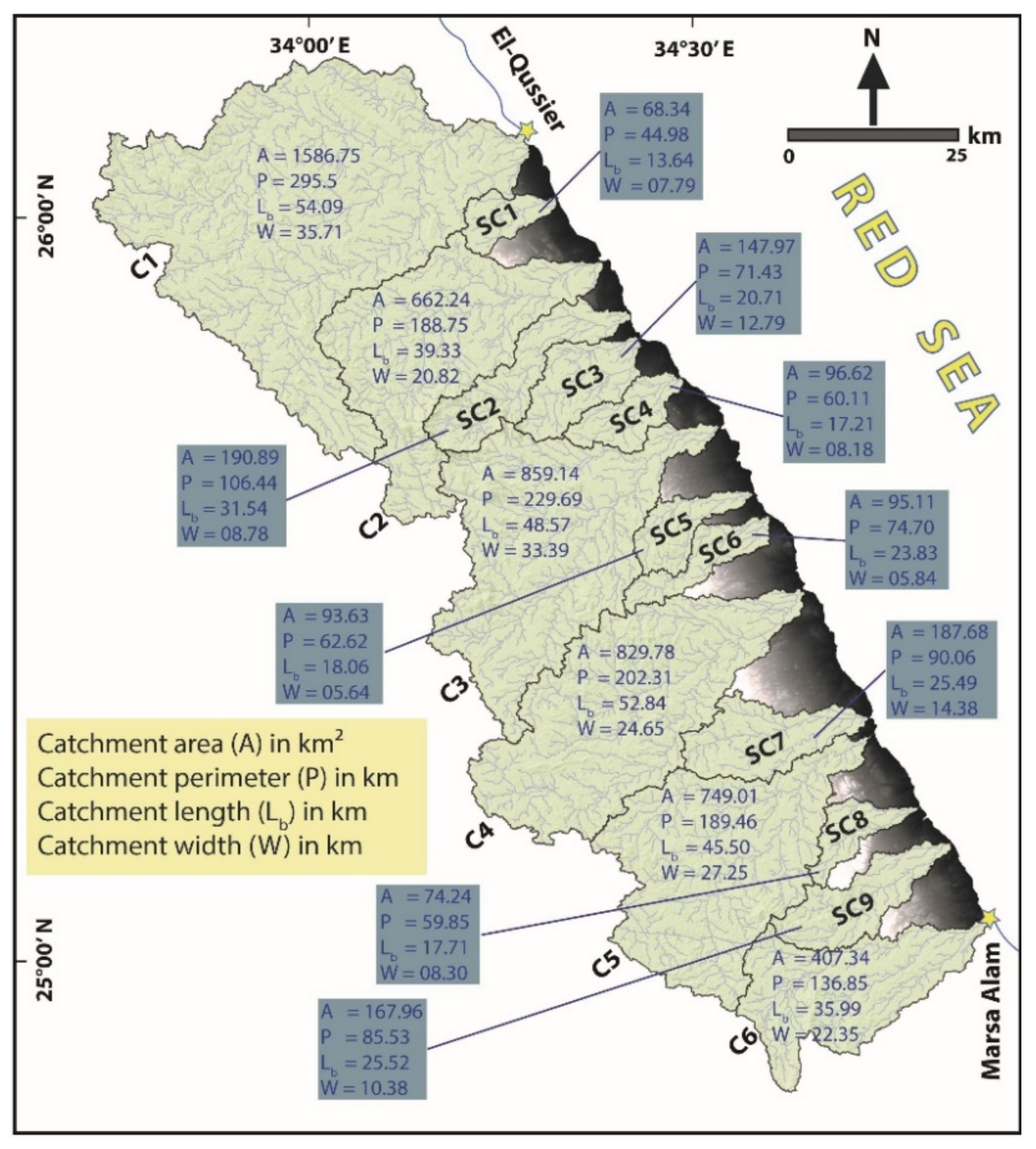Morphometric-hydro Characterization of the Coastal Line between El-Qussier and Marsa-Alam, Egypt: Preliminary Flood Risk Signatures
Abstract
:1. Introduction
2. Study Area
2.1. Description of the Research Area
2.2. Geological Setting
3. Data Collection and Methods
3.1. Morphometric Parameters
3.1.1. Catchment Geometry Indexes
3.1.2. Stream Indexes
3.1.3. Areal Indexes
3.1.4. Catchment Relief Indexes
3.2. SCS-CN Model
3.3. Watershed Modeling System (WMS)
3.4. Flash Flood Hazards Assessment Parameters
4. Results
4.1. Quantitative Morphometric Analysis
4.2. Curve Number (CN)
4.3. Watershed Modeling System (WMS)
4.4. Flood Risk Assessment
5. Discussion
6. Conclusions and Recommendations
- Studying in details the seismic/tectonic behaviors of the future strategic projects and huge constructions.
- Constructing dams in the most hazardous spots along the specific valleys.
- Initiating channels and valleys mouths to receive the great rainfall accumulation toward the Red Sea.
- Planning the future major projects and constructions to be away from the courses of the major floods.
- Establishing hazard monitoring stations along the risky regions.
Author Contributions
Funding
Informed Consent Statement
Data Availability Statement
Acknowledgments
Conflicts of Interest
References
- IFRC. World Disasters Report 2020: Come Heat or High Water; IFRC: Paris, France, 2020. [Google Scholar]
- Boruff, B.J. Environmental Hazards: Assessing Risk and Reducing Disasters, 5th; Smith, K., David, N., Eds.; Routledge: London, UK, 2009; Volume 47, pp. 454–455. [Google Scholar] [CrossRef]
- Dankers, R.; Feyen, L. Flood Hazard in Europe in an Ensemble of Regional Climate Scenarios. J. Geophys. Res. Atmos. 2009, 114, 1–16. [Google Scholar] [CrossRef]
- Velasco, M.; Versini, P.A.; Cabello, A.; Barrera-Escoda, A. Assessment of Flash Floods Taking into Account Climate Change Scenarios in the Llobregat River Basin. Nat. Hazards Earth Syst. Sci. 2013, 13, 3145–3156. [Google Scholar] [CrossRef] [Green Version]
- Wu, S.H.; Pan, T.; He, S.F. Climate Change Risk Research: A Case Study on Flood Disaster Risk in China. Adv. Clim. Chang. Res. 2012, 3, 92–98. [Google Scholar] [CrossRef]
- Davis, R. World Disaster Report—Most Deaths Caused by Food. 2014. Available online: https://floodlist.com/dealing-with-floods/world-disasters-report-100-million-affected-2013 (accessed on 6 October 2016).
- Prama, M.; Omran, A.; Schröder, D.; Abouelmagd, A. Vulnerability Assessment of Flash Floods in Wadi Dahab Basin, Egypt. Environ. Earth Sci. 2020, 79, 114. [Google Scholar] [CrossRef] [Green Version]
- Youssef, A.M.; Pradhan, B.; Hassan, A.M. Flash Flood Risk Estimation along the St. Katherine Road, Southern Sinai, Egypt Using GIS Based Morphometry and Satellite Imagery. Environ. Earth Sci 2011, 62, 611–623. [Google Scholar] [CrossRef]
- Bathrellos, G.D.; Karymbalis, E.; Skilodimou, H.D.; Gaki-Papanastassiou, K.; Baltas, E.A. Urban Flood Hazard Assessment in the Basin of Athens Metropolitan City, Greece. Environ. Earth Sci. 2016, 75, 319. [Google Scholar] [CrossRef]
- Petrucci, O.; Aceto, L.; Bianchi, C.; Bigot, V.; Br, R.; Pereira, S.; Kahraman, A.; Kılıç, Ö.; Kotroni, V.; Llasat, M.C.; et al. Flood Fatalities in Europe, 1980–2018: Variability, Features, and Lessons to Learn. Water 2019, 11, 1682. [Google Scholar] [CrossRef] [Green Version]
- Moawad, M.B. Analysis of the Flash Flood Occurred on 18 January 2010 in Wadi El Arish, Egypt (a Case Study). Geomat. Nat. Hazards Risk 2013, 4, 254–274. [Google Scholar] [CrossRef] [Green Version]
- Youssef, A.M.; Sefry, S.A.; Pradhan, B.; Alfadail, E.A. Analysis on Causes of Flash Flood in Jeddah City (Kingdom of Saudi Arabia) of 2009 and 2011 Using Multi-Sensor Remote Sensing Data and GIS. Geomat. Nat. Hazards Risk 2016, 7, 1018–1042. [Google Scholar] [CrossRef]
- Khalifa, A.; Çakır, Z.; Kaya, Ş.; Gabr, S. ASTER Spectral Band Ratios for Lithological Mapping: A Case Study for Measuring Geological Offset along the Erkenek Segment of the East Anatolian Fault Zone, Turkey. Arab. J. Geosci. 2020, 13, 832. [Google Scholar] [CrossRef]
- Buczek, K.; Górnik, M. Evaluation of Tectonic Activity Using Morphometric Indices: Case Study of the Tatra Mts. (Western Carpathians, Poland). Environ. Earth Sci. 2020, 79, 1–13. [Google Scholar] [CrossRef] [Green Version]
- Khalifa, A.; Bashir, B.; Çakir, Z.; Kaya, Ş.; Alsalman, A.; Henaish, A. Paradigm of Geological Mapping of the Adıyaman Fault Zone of Eastern Turkey Using Landsat 8 Remotely Sensed Data Coupled with Pca, Ica, and Mnfa Techniques. ISPRS Int. J. Geo-Inf. 2021, 10, 368. [Google Scholar] [CrossRef]
- Khalifa, A.; Bashir, B.; Alsalman, A.; Öğretmen, N. Morpho-Tectonic Assessment of the Abu-Dabbab Area, Eastern Desert, Egypt: Insights from Remote Sensing and Geospatial Analysis. ISPRS Int. J. Geo-Inf. 2021, 10, 784. [Google Scholar] [CrossRef]
- Khalifa, A.; Çakir, Z.; Owen, L.A. Kaya. Evaluation of the Relative Tectonic Activity of the Adıyaman Fault within the Arabian-Anatolian Plate Boundary (Eastern Turkey). Geol. Acta 2019, 17, 1–17. [Google Scholar] [CrossRef] [Green Version]
- Baruah, M.P.; Bezbaruah, D.; Goswami, T.K. Active Tectonics Deduced from Geomorphic Indices and Its Implication on Economic Development of Water Resources in South-Eastern Part of Mikir Massif, Assam, India. Geol. Ecol. Landscapes 2020, 6, 1–14. [Google Scholar] [CrossRef]
- Bhattarai, I.; Gani, N.D.; Xue, L. Geomorphological Responses of Rivers to Active Tectonics along the Siwalik Hills, Midwestern Nepalese Himalaya. J. Mt. Sci. 2021, 18, 1268–1294. [Google Scholar] [CrossRef]
- Gülbaz, S.; Kazezyılmaz-Alhan, C.M.; Bahçeçi, A.; Boyraz, U. Flood Modeling of Ayamama River Watershed in Istanbul, Turkey. J. Hydrol. Eng. 2019, 24, 05018026. [Google Scholar] [CrossRef]
- Kamel, M.; Arfa, M. Integration of Remotely Sensed and Seismicity Data for Geo-Natural Hazard Assessment along the Red Sea Coast, Egypt. Arab. J. Geosci. 2020, 13, 1–23. [Google Scholar] [CrossRef]
- Khalifa, A. Preliminary Active Tectonic Assessment of Wadi Ghoweiba Catchment, Gulf of Suez Rift, Egypt, Integration of Remote Sensing, Tectonic Geomorphology, and Gis Techniques. Al Azhar Bull. Sci. 2020, 31, 35–42. [Google Scholar] [CrossRef]
- Ezati, M.; Gholami, E. Neotectonics of the Central Kopeh Dagh Drainage Basins, NE Iran. Arab. J. Geosci. 2022, 15, 1–18. [Google Scholar] [CrossRef]
- Elnazer, A.A.; Salman, S.A.; Asmoay, A.S. Flash Flood Hazard Affected Ras Gharib City, Red Sea, Egypt: A Proposed Flash Flood Channel. Nat. Hazards 2017, 89, 1389–1400. [Google Scholar] [CrossRef]
- Helmi, A.M.; Zohny, O. Flash Flood Risk Assessment in Egypt; Springer: Cham, Switzerland, 2020. [Google Scholar] [CrossRef]
- Youssef, A.M.; Pradhan, B.; Gaber, A.F.D.; Buchroithner, M.F. Geomorphological Hazard Analysis along the Egyptian Red Sea Coast between Safaga and Quseir. Nat. Hazards Earth Syst. Sci. 2009, 9, 751–766. [Google Scholar] [CrossRef]
- Arnous, M.O.; Green, D.R. Monitoring and Assessing Waterlogged and Salt-Affected Areas in the Eastern Nile Delta Region, Egypt, Using Remotely Sensed Multi-Temporal Data and GIS. J. Coast. Conserv. 2015, 19, 369–391. [Google Scholar] [CrossRef]
- NOAA. Hurguada (Hurghada) Climate Normals 1961–1990; National Oceanic and Atmospheric Administration: Washington, DC, USA, 2015. [Google Scholar]
- Conoco and General Petroleum Corporation. Geological Map of Egypt, Scale 1:500,000; Gebel Hamata: Cairo, Egypt, 1987. [Google Scholar]
- Abdel Moneim, A.A. Overview of the Geomorphological and Hydrogeological Characteristics of the Eastern Desert of Egypt. Hydrogeol. J. 2005, 13, 416–425. [Google Scholar] [CrossRef]
- El Fakharany, M.A. Drainage Basins and Flash Floods Management in the Area Southeast Qena, Eastern Desert, Egypt. Egypt. J. Geol. 1998, 42, 737–750. [Google Scholar]
- Altaf, F.; Meraj, G.; Romshoo, S.A. Morphometric Analysis to Infer Hydrological Behaviour of Lidder Watershed, Western Himalaya, India. Geogr. J. 2013, 2013, 1–14. [Google Scholar] [CrossRef]
- Dewidar, K.M. Analysis of Morphometric Parameters Using Remote-Sensing Data and GIS Techniques in the Wadi El Gemal Basin, Red Sea Coast. Int. J. Remote SensGIS 2013, 2, 122–129. [Google Scholar]
- Schumm, S.A. Evolution of Drainage Systems and Slopes in Badlands at Perth Amboy, New Jersey. Bull. Geol. Soc. Am. 1956, 67, 597–646. [Google Scholar] [CrossRef]
- Rallison, R.E. Origin and Evolution of the SCS Runoff Equation. In Proceedings of the 1980 Watershed Management Symposium, Boise, ID, USA, 21–23 July 1980. [Google Scholar]
- El-Fakharany, M.A.; Mansour, N.M. Morphometric Analysis and Flash Floods Hazards Assessment for Wadi Al Aawag Drainage Basins, Southwest Sinai, Egypt. Environ. Earth Sci. 2021, 80, 1–17. [Google Scholar] [CrossRef]
- Horton, R.E. Erosional Development of Streams and Their Drainage Basins: Hydrophysical Approach to Quantitative Morphology. J. Jpn. For. Soc. 1945, 56, 275–370. [Google Scholar] [CrossRef] [Green Version]
- Strahler, A.N. Quantitative Geomorphology of Drainage Basins and Channel Networks. In In Handbook of Applied Hydrology; Chow, V.T., Ed.; McGraw Hill: New York, NY, USA, 1964; pp. 4–11. [Google Scholar]
- Horton, R.E. Drainage-basin Characteristics. EOS Trans. Am. Geophys. Union 1932, 13, 350–361. [Google Scholar] [CrossRef]
- Strahler, A. Dynamic Basis of Geomorphology. Geol. Soc. Am. Bull. 1952, 63, 923–938. [Google Scholar] [CrossRef]
- Miller, V.C. A Quantitative Geomorphic Study of Drainage Basin Characteristics in the Clinch Mountain Area, Virginia and Tennessee; Columbia University, Department of Geology: New York, NY, USA, 1953; pp. 389–402. [Google Scholar]
- Satheeshkumar, S.; Venkateswaran, S.; Kannan, R. Rainfall–Runoff Estimation Using SCS–CN and GIS Approach in the Pappiredipatti Watershed of the Vaniyar Sub Basin, South India. Model. Earth Syst. Environ. 2017, 3, 1–8. [Google Scholar] [CrossRef] [Green Version]
- Ponce, V.M.; Hawkins, R.H. Runoff Curve Number: Has It Reached Maturity? J. Hydrol. Eng. 1996, 1, 11–19. [Google Scholar] [CrossRef]
- Cronshey, R. Urban Hydrology for Small Watersheds; Technical Release 55; United States Department of Agriculture; Natural Resources Conservation Service; Conservation Engineering Division: Washington, DC, USA, 1986. [Google Scholar]
- Mckeever, V. National Engineering Handbook, Section 4 Hydrology; USDA-SCS: Washington, DC, USA, 1972. [Google Scholar]
- Skaags, R.W.; Khaleel, R. Infiltration, Hydrologic Modeling of Small Watershed; American Society of Agricultural Engineers: St. Joseph, MI, USA, 1982; Volume 13, pp. 123–124. [Google Scholar]
- Sherwood, J.M. Estimation of Flood Volumes and Simulation of Flood Hydrographs for Ungaged Small Rural Streams in Ohio. Water-Resour. Investig. Rep. 1993, 52, 4080. [Google Scholar]
- Sultan, S.A.; Mohameden, M.I.; Santos, F.M. Hydrogeophysical Study of the El Qaa Plain, Sinai, Egypt. Bull. Eng. Geol. Environ. 2009, 68, 525–537. [Google Scholar] [CrossRef]
- Abduladheem, A.; Elmewafey, M.; Beshr, A. Using-GIS-Based-Morphometry-Estimation-of-Flood-Hazard-Impacts-on-Desert-Roads-in-South-Sinai-Egypt. Int. J. Sci. Eng. Res. 2015, 6, 1593–1599. [Google Scholar]
- Frihy, O.; Mohamed, S.; Abdalla, D.; El-Hattab, M. Assessment of Natural Coastal Hazards at Alexandria/Nile Delta Interface, Egypt. Environ. Earth Sci. 2021, 80, 1–15. [Google Scholar] [CrossRef]
- Dawod, G.M.; Mirza, M.N.; Al-Ghamdi, K.A. GIS-Based Spatial Mapping of Flash Flood Hazard in Makkah City, Saudi Arabia. J. Geogr. Inf. Syst. 2011, 3, 225–231. [Google Scholar] [CrossRef] [Green Version]
- El-Magd, I.A.; Hermas, E.; El-Bastawesy, M. GIS-Modelling of the Spatial Variability of Flash Flood Hazard in Abu Dabbab Catchment, Red Sea Region, Egypt. Egypt. J. Remote Sens. Sp. Sci. 2010, 13, 81–88. [Google Scholar] [CrossRef] [Green Version]
- Wahid, A.; Madden, M.; Khalaf, F.; Fathy, I. Geospatial Analysis for the Determination of Hydro-Morphological Characteristics and Assessment of Flash Flood Potentiality in Arid Coastal Plains: A Case in Southwestern Sinai, Egypt. Earth Sci. Res. J. 2016, 20, E1–E9. [Google Scholar] [CrossRef]
- Mohamed, S.A.; El-Raey, M.E. Vulnerability Assessment for Flash Floods Using GIS Spatial Modeling and Remotely Sensed Data in El-Arish City, North Sinai, Egypt. Nat. Hazards 2020, 102, 707–728. [Google Scholar] [CrossRef]
- Ullah, K.; Zhang, J. GIS-Based Flood Hazard Mapping Using Relative Frequency Ratio Method: A Case Study of Panjkora River Basin, Eastern Hindu Kush, Pakistan. PLoS ONE 2020, 15, 1–18. [Google Scholar] [CrossRef] [Green Version]
- Máčka, Z. Determination of Texture of Topography from Large Scale Contour Maps. Geogr. Vestn. 2001, 73. [Google Scholar]
- Khalifa, A.; Çakir, Z.; Owen, L.A.; Kaya, Ş. Morphotectonic Analysis of the East Anatolian Fault, Turkey. Turk. J. Earth Sci. 2018, 27, 110–126. [Google Scholar] [CrossRef]
- El Maghraby, M.; Masoud, M.; Niyazi, B. Assessment of Surface Runoff in Arid, Data Scarce Regions; an Approach Applied in Wadi Al Hamd, Al Madinah Al Munawarah, Saudi Arabia. Life Sci. J. 2014, 11, 271–289. [Google Scholar]
- Yousif, M.; Hussien, H.M. Correction to: Flash Floods Mitigation and Assessment of Groundwater Possibilities Using Remote Sensing and GIS Applications: Sharm El Sheikh, South Sinai, Egypt. Bull. Natl. Res. Cent. 2020, 44, 1–15. [Google Scholar] [CrossRef]
- Meraj, G.; Romshoo, S.A.; Yousuf, A.R.; Altaf, S.; Altaf, F. Assessing the Influence of Watershed Characteristics on the Flood Vulnerability of Jhelum Basin in Kashmir Himalaya. Nat. Hazards 2015, 77, 153–175. [Google Scholar] [CrossRef]
- Masoud, A.A. Runoff Modeling of the Wadi Systems for Estimating Flash Flood and Groundwater Recharge Potential in Southern Sinai, Egypt. Arab. J. Geosci. 2011, 4, 785–801. [Google Scholar] [CrossRef]
- El-Rakaiby, M.L. Drainage Basins and Flash Flood Hazard in Selected Parts of Egypt. Egypt. J. Geol. 1989, 33, 307–323. [Google Scholar]











| Data | Sources | Date | Resolution |
|---|---|---|---|
| Shuttle Radar Topography Mission (STRM) digital elevation model data | https://earthexplorer.usgs.gov/ |
23 September 2014 00:00:00-05 | 30-m resolution |
| Geological maps of Egypt | EGPC and CONOCO, “Egyptian General Petroleum Corporation and CONOCO”, A geological map of Egypt | 1987 | 1:500,000 scale |
| Morphometric Indexes | Formula | References | |
|---|---|---|---|
| Catchment geometry | Area index (A) | ArcHydro analysis | [34] |
| Length index (Lb) | ArcHydro analysis | [34] | |
| Width index (W) | ArcHydro analysis | [34] | |
| Perimeter index (P) | ArcHydro analysis | [34] | |
| Stream indexes | Stream order (Su) | Hierarchial rank | [21,36] |
| Stream length (Lu) in km | Lu = L1 + L2 + …… Ln | [21,39] | |
| Bifurcation ratio (Rb) | Rb = Nu/Nu + 1 | [21,34] | |
| Stream number (Nu) | Nu = N1 + N2 + …… Nn | [40] | |
| Areal indexes | Drainage frequency (F) | TSN/A | [40] |
| Drainage density (Dd) | TSL/A | [40] | |
| Drainage basin shape (Bsh) | Lb2/A | [16,40] | |
| Drainage elongation ratio (Re) | 1.128 × A0.5/Lb | [34] | |
| Drainage circularity ratio (Rc) | 4πA/P2 | [41] | |
| Relief indexes | Catchment relief (R) | H = Z − z | [41] |
| Catchment relief ratio (Rr) | R/Lb | [34] | |
| Catchment ruggedness no. (Rn) | Dd × (R/1000) | [34] | |
| Equation | Abbreviation Description |
|---|---|
| TLag = L0.8(S + Ia)0.7/1900√Y | TLag: lag time (h); Y: basin slope (%); Tc: time of concentration (min); V: flow velocity; La: catchment length; Qp: peak discharge (m3/s); A: catchment area (Km2); Tp: time to peak (h); Δt: duration of designed storm; Q: direct runoff (mm); p: rainfall return periods (cm); S: potential maximum retention (mm); Ia: amount of total water before of flood; CN: curve number |
| Tc = 0.0001(L0.77/S0.385) | |
| V = 0.2279La/TC | |
| Qp = 0.208A/Tp | |
| Tp = Δt/2 + TLag | |
| Q = (p − 0.2S)2/(p + 0.8S) | |
| Q = (p − Ia)2/(p − Ia + S) | |
| Ia = 0.2S | |
| S = 1000 − 10CN/CN S = 25,400 − 254CN/CN |
| Catchments/ Sub-Catchments | Area (km2) | Perimeter (km) | Length (km) | Width (km) |
|---|---|---|---|---|
| C1 | 1586.75 | 295.55 | 54.09 | 35.71 |
| C2 | 662.24 | 188.75 | 39.33 | 20.82 |
| C3 | 859.14 | 229.69 | 48.57 | 33.39 |
| C4 | 829.78 | 202.31 | 52.84 | 24.65 |
| C5 | 749.01 | 189.46 | 45.50 | 27.25 |
| C6 | 407.34 | 136.85 | 35.99 | 22.35 |
| SC1 | 68.34 | 44.98 | 13.64 | 07.79 |
| SC2 | 190.89 | 106.44 | 31.54 | 08.78 |
| SC3 | 147.97 | 71.43 | 20.71 | 12.79 |
| SC4 | 96.62 | 60.11 | 17.21 | 08.18 |
| SC5 | 93.63 | 62.62 | 18.06 | 05.64 |
| SC6 | 95.11 | 74.70 | 23.83 | 05.84 |
| SC7 | 187.68 | 90.06 | 25.49 | 14.38 |
| SC8 | 74.24 | 59.85 | 17.71 | 08.30 |
| SC9 | 167.96 | 85.53 | 25.52 | 10.38 |
| Catchments/Sub-Catchments | Stream Indexes | Areal Indexes | Relief Indexes | ||||||||
|---|---|---|---|---|---|---|---|---|---|---|---|
| Rb | Lu (m) | ΣNu | Rc | Re | Bsh | Dd | F | R (m) | Rr (m/km) | Rn | |
| C1 | 2.43 | 1358.47 | 1070 | 0.22 | 0.83 | 1.84 | 0.856 | 0.674 | 1088 | 20.11 | 0.94 |
| C2 | 1.71 | 584.32 | 448 | 0.23 | 0.73 | 2.33 | 0.882 | 0.671 | 1447 | 36.78 | 1.27 |
| C3 | 1.79 | 769.09 | 561 | 0.20 | 0.68 | 2.74 | 0.895 | 0.653 | 1332 | 27.41 | 1.19 |
| C4 | 2.34 | 719.04 | 540 | 0.25 | 0.61 | 3.36 | 0.866 | 0.650 | 1007 | 19.05 | 0.87 |
| C5 | 2.39 | 651.18 | 484 | 0.26 | 0.67 | 2.76 | 0.869 | 0.647 | 937 | 20.59 | 0.81 |
| C6 | 3.74 | 374.61 | 264 | 0.27 | 0.63 | 3.18 | 0.919 | 0.642 | 1165 | 32.36 | 1.07 |
| SC1 | 1.79 | 55.80 | 34 | 0.42 | 0.68 | 2.72 | 0.816 | 0.491 | 312 | 22.87 | 0.25 |
| SC2 | 1.97 | 178.36 | 134 | 0.21 | 0.49 | 5.21 | 0.934 | 0.702 | 1432 | 45.38 | 1.33 |
| SC3 | 2.23 | 150.35 | 95 | 0.36 | 0.66 | 2.89 | 1.016 | 0.642 | 1058 | 51.07 | 1.07 |
| SC4 | 1.53 | 91.36 | 53 | 0.33 | 0.64 | 3.06 | 0.945 | 0.543 | 350 | 20.32 | 0.33 |
| SC5 | 2.09 | 78 | 56 | 0.29 | 0.60 | 3.48 | 0.833 | 0.592 | 575 | 31.82 | 0.47 |
| SC6 | 2.61 | 89.76 | 51 | 0.21 | 0.46 | 5.97 | 0.943 | 0.532 | 609 | 25.55 | 0.57 |
| SC7 | 1.99 | 161.35 | 123 | 0.29 | 0.60 | 3.46 | 0.859 | 0.659 | 483 | 18.94 | 0.41 |
| SC8 | 1.60 | 65.35 | 45 | 0.26 | 0.54 | 4.22 | 0.880 | 0.602 | 408 | 23.03 | 0.35 |
| SC9 | 1.98 | 155.31 | 114 | 0.28 | 0.57 | 3.87 | 0.924 | 0.677 | 942 | 36.90 | 0.87 |
| Main Catchments | Catchments Hydrological Data | 2009 Storm Event | 2019 Storm Event | |||||
|---|---|---|---|---|---|---|---|---|
| CN | TLag (h) | V (m/s) | Tc (h) | Qp (m3/S) | Qt (m3) | Qp (m3/S) | Qt (m3) | |
| C1 | 83.75 | 2.42 | 26.59 | 7.724 | 70 | 733,184.00 | 51 | 512,000.00 |
| C2 | 82.36 | 2.19 | 26.71 | 5.592 | 36 | 250,048.00 | 19 | 167,936.00 |
| C3 | 80.66 | 2.38 | 27.39 | 6.736 | 77 | 618,496.00 | 42 | 81,920.00 |
| C4 | 82.50 | 2.46 | 28.92 | 6.939 | 113 | 831,488.00 | 63 | 491,520.00 |
| C5 | 84.30 | 2.08 | 26.27 | 6.578 | 46 | 368,640.00 | 26 | 221,184.00 |
| C6 | 85.20 | 1.89 | 29.89 | 4.573 | 57 | 507,904.00 | 30 | 319,488.00 |
| SUM. | 3,309,760.00 | 1,794,048.00 | ||||||
Publisher’s Note: MDPI stays neutral with regard to jurisdictional claims in published maps and institutional affiliations. |
© 2022 by the authors. Licensee MDPI, Basel, Switzerland. This article is an open access article distributed under the terms and conditions of the Creative Commons Attribution (CC BY) license (https://creativecommons.org/licenses/by/4.0/).
Share and Cite
Khalifa, A.; Bashir, B.; Alsalman, A.; Bachir, H. Morphometric-hydro Characterization of the Coastal Line between El-Qussier and Marsa-Alam, Egypt: Preliminary Flood Risk Signatures. Appl. Sci. 2022, 12, 6264. https://doi.org/10.3390/app12126264
Khalifa A, Bashir B, Alsalman A, Bachir H. Morphometric-hydro Characterization of the Coastal Line between El-Qussier and Marsa-Alam, Egypt: Preliminary Flood Risk Signatures. Applied Sciences. 2022; 12(12):6264. https://doi.org/10.3390/app12126264
Chicago/Turabian StyleKhalifa, Abdelrahman, Bashar Bashir, Abdullah Alsalman, and Hussein Bachir. 2022. "Morphometric-hydro Characterization of the Coastal Line between El-Qussier and Marsa-Alam, Egypt: Preliminary Flood Risk Signatures" Applied Sciences 12, no. 12: 6264. https://doi.org/10.3390/app12126264
APA StyleKhalifa, A., Bashir, B., Alsalman, A., & Bachir, H. (2022). Morphometric-hydro Characterization of the Coastal Line between El-Qussier and Marsa-Alam, Egypt: Preliminary Flood Risk Signatures. Applied Sciences, 12(12), 6264. https://doi.org/10.3390/app12126264








